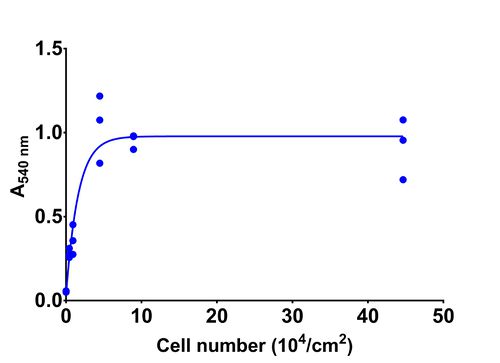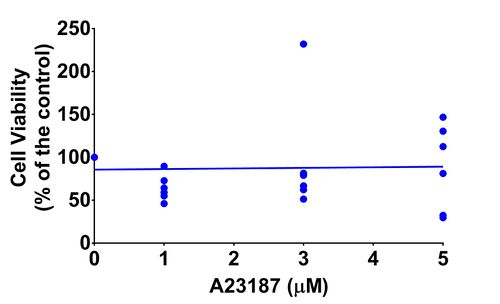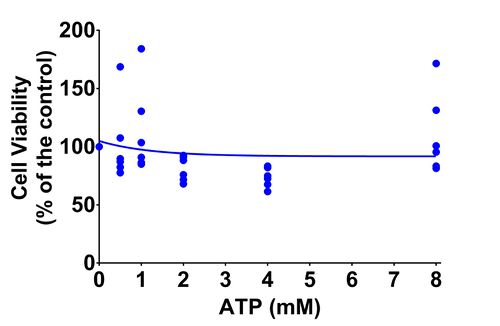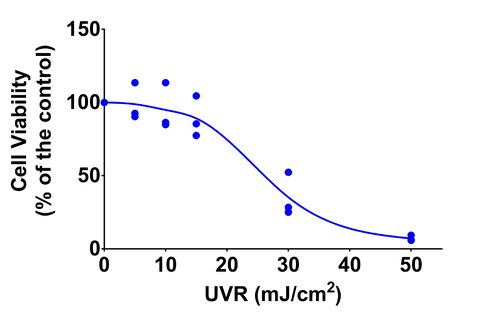HaCaT MTT Assay Results
In this study, the aim was to identify optimal conditions for the following experiments. These assays were performed using the MTT assay.
Optimum seeding density
HaCaT keratinocytes were seeded at set densities between 0.4-44 x104 cells/cm2 in order to create a growth curve (Figure *). The exponential growth phase was identified between 0.4 x10^4 and 4 x10^4 cells/cm2. As a result, a value in the centre of the exponential growth phase was selected (2 x10^4 cells/cm2) and used in all future experiments.
| Cell number (10^4/cm2) | A540 nm |
|---|---|
| 0 | 0.05 ± 0.00 |
| 0.44 | 0.28 ± 0.03 |
| 0.91 | 0.36 ± 0.09 |
| 4.47 | 1.04 ± 0.20 |
| 8.94 | 0.95 ± 0.05 |
| 44.66 | 0.92 ± 0.18 |
Cell viability
HaCaT keratinocytes were exposed to varying doses of A23187, ATP and UVR to assess toxicity. The range of doses which were assessed was based upon doses used in the literature (Norris et al., 2014, Sjursen et al., 2000, Aries et al., 2005, Gresham et al., 1996).
When the viability was assessed for cells exposed to A23187 (0-5 µM) for 6h, the mean of all doses was found to be above 80% except 1 µM. 5 µM was used in future experiments as the mean viability was above 80% and it had previously been shown to upregulate the AA cascade (Aries et al., 2005, Sjursen et al., 2000). The mean viability of cells exposed to ATP (0-8 mM) for 6h was found to remain above 80% for all doses. Based upon previous reports, 2 mM of ATP was sufficient to upregulate the AA cascade (Norris et al., 2014), therefore was used in future experiments.
The mean viability of cells following irradiation with UVR (0-50 mJ/cm2) was found to decrease as the dose of UVR increased. 15 mJ/cm2 was found to be the highest dose of UVR where the mean viability of cells was over 80% after 6h. As a result, this was used for all future experiments.
Calcium Ionophore
| A23187 (µM) | Cell Viability (% of the control) |
|---|---|
| 0 | 100.00 ± 0.00 |
| 1 | 64.42 ± 15.19 |
| 3 | 95.42 ± 67.83 |
| 5 | 88.75 ± 49.79 |
ATP
| ATP (mM) | Cell Viability (% of the control) |
|---|---|
| 0 | 100.00 ± 0.00 |
| 0.5 | 102.18 ± 34.13 |
| 1 | 113.40 ± 38.55 |
| 2 | 81.26 ± 10.64 |
| 4 | 73.65 ± 8.40 |
| 8 | 110.63 ± 34.83 |
UVR
| UVR (mJ/cm2) | Cell Viability (% of the control) |
|---|---|
| 0 | 100.00 ± 0.00 |
| 5 | 98.80 ± 12.80 |
| 10 | 94.89 ± 16.15 |
| 15 | 89.11 ± 13.92 |
| 30 | 35.21 ± 14.84 |
| 50 | 7.04 ± 1.92 |



